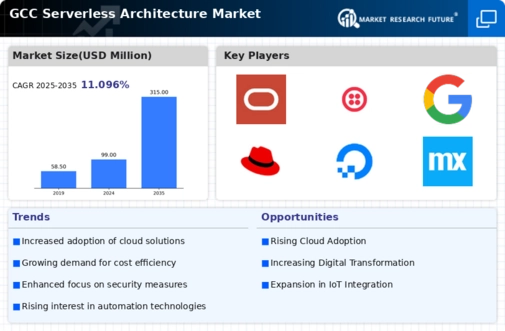Growing Demand for Scalability
the serverless architecture market experiences a notable surge in demand for scalability solutions. Organizations in the GCC region are increasingly seeking flexible computing resources that can automatically adjust to varying workloads. This demand is driven by the need for businesses to efficiently manage fluctuating traffic without incurring unnecessary costs. According to recent data, the serverless architecture market is projected to grow at a CAGR of 25% from 2025 to 2030. This growth indicates a strong preference for scalable solutions that allow companies to focus on core business functions while the infrastructure dynamically adapts to their needs. As a result, the serverless architecture market becomes a preferred choice for enterprises aiming to enhance operational efficiency and responsiveness.
Emergence of Innovative Startups
The serverless architecture market is witnessing a surge in innovative startups that are developing cutting-edge solutions tailored to the unique needs of businesses in the GCC. These startups are leveraging serverless technologies to create applications that are not only cost-effective but also highly scalable and efficient. The influx of new players in the market is fostering competition and driving advancements in serverless offerings. Recent data indicates that the number of startups focusing on serverless solutions in the GCC has increased by 40% over the past year. This emergence of innovative startups is likely to enhance the serverless architecture market, as they introduce novel approaches and functionalities that cater to diverse industry requirements.
Rising Interest in DevOps Practices
The serverless architecture market is increasingly influenced by the growing interest in DevOps practices among organizations in the GCC. DevOps emphasizes collaboration between development and operations teams, facilitating faster deployment and improved software quality. Serverless architecture aligns well with these practices, enabling teams to focus on writing code without the burden of managing infrastructure. As a result, many companies are adopting serverless solutions to streamline their development processes. Data suggests that organizations implementing DevOps methodologies experience a 30% reduction in time-to-market for new applications. This trend indicates that the serverless architecture market is likely to expand as more businesses recognize the advantages of integrating DevOps with serverless technologies.
Enhanced Focus on Security and Compliance
In the GCC region, the serverless architecture market is witnessing an increased emphasis on security and compliance measures. As organizations migrate to serverless solutions, they are prioritizing the protection of sensitive data and adherence to regulatory standards. This focus is particularly relevant in industries such as finance and healthcare, where data breaches can have severe consequences. The market is responding by integrating advanced security features into serverless platforms, ensuring that businesses can operate within compliance frameworks. Recent statistics indicate that 70% of organizations in the GCC are investing in enhanced security protocols for their serverless applications. This trend underscores the importance of security in driving the adoption of serverless architecture, as companies seek to mitigate risks while leveraging the benefits of cloud computing.
Increased Investment in Digital Transformation
The serverless architecture market is benefiting from the heightened investment in digital transformation initiatives across the GCC region. Organizations are increasingly recognizing the need to modernize their IT infrastructure to remain competitive in a rapidly evolving digital landscape. Serverless architecture offers a compelling solution by providing the agility and flexibility required for digital transformation. Recent reports indicate that 60% of GCC companies are allocating significant budgets towards cloud-based solutions, including serverless technologies, to enhance their operational capabilities. This trend suggests that the serverless architecture market is poised for growth as businesses seek to leverage innovative technologies to drive efficiency and improve customer experiences.

















Leave a Comment